Introduction to the Solidi of Anthemius
Libius Severus died on 15 August 465 (the usually stated date, 14 November, is a modern concoction by Otto Seeck). For some reason Ricimer, who had been behind the appointments of Majorian and Severus, did nothing. As was the normal procedure in the West, the Eastern emperor, Leo, was considered emperor of the entire empire and when coinage was necessary it was struck in his name (RIC 2517-2530). Senatorial envoys were sent many times to Leo asking that he appoint a western colleague but until the Vandals directly threatened the East with raiding in 466 he turned a deaf ear to them. The threat to the East must have been great and imminent: the size of the expedition and its cost were almost astronomical by contemporary standards: 1,113 ships, over 100,000 men, and 130,000 pounds of gold (almost 9.4 million solidi if it had all been coined) plus the res priuatae and whatever the West could provide.
In order to gain the cooperation and involvement of
the West (and its army), which had no emperor, Leo selected Procopius
Anthemius, the son-in-law of the emperor Marcian, as Western emperor (note that
PLRE 2: 96, s.v. Anthemius 3, is
ignorant of his first name, since it knows nothing of the coinage, the only
evidence for the name). This was
no doubt a strategic political move on Leo’s part, getting rid of a potential
rival who Sidonius implies was a potential and natural successor to Marcian. Anthemius was sent overland (not by
sea) during the winter of 466-7 and was proclaimed emperor on 12 April 467 by
the army at Brontodas (= Bront≈dhw), probably an imperial villa, eight miles from
Rome. Bearing letters from Leo he
was readily accepted by a grateful senate.
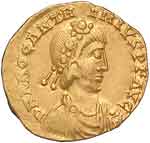 Series One
Series One 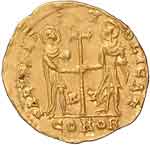
Given his proximity to Rome Anthemius’ first coins were certainly struck there. News would have been sent on ahead as he headed west and a large quantity of solidi would have been on hand for distribution as a donative on the day of the proclamation. These were certainly RIC 2801, with the new emperor’s full name (PROC(opius) ANTHEMIVS) and the normal Western obverse type (RIC’s D4, right-facing draped and cuirassed rosette and pearl diademed bust), but, for the first time since the accession of Valentinian III in 425, with a new regular reverse type with the legend SALVS REIPVBLICAE. This legend harkened back to the issues of 425 struck by Galla Placidia in Aquileia in the name of Theodosius II for the young caesar Valentinian III, also sent to the West by an Eastern emperor (RIC 1805-7). These in turn took their cue from a series struck in Constantinople celebrating Valentinian III’s return to the West and the joint consulship of Theodosius and Valentinian in 425 (RIC 233-6). This small series was followed by a larger one in 426 for their second joint consulship (RIC 237-45). On the new reverse, however, instead of the two emperors as consuls as on the Aquileian and Constantinopolitan types, since neither was consul at the time, the emperors are (suitably for the circumstances) depicted as generals, each standing, draped and cuirassed with helmet and spear, both supporting in the centre a single globus cruciger, representing the Christian state. Following usual western practice neither is nimbate. Instead of a mint mark a star, so common on Eastern reverses since the birth of Theodosius, appears in the field, another holdover from the Aquileian reverse where it stands above and between the two imperial consuls. The lack of a mint mark is no impediment to assigning this issue to Rome: its style is exactly what we see in the last Roman issues of Severus (RIC 2703-6) and Leo (noted above). But minting was very limited: no more than was needed for the accession donative seems to have been struck.
Minting also took place at the same time at Ravenna, no doubt for distribution to the civil service and other imperial bureaucracies. It employed the same legend and Western-style obverse as was used at Rome (D4) but with a different, less military reverse: two tall draped and (unusually) nimbate emperors facing each other each holding a globe in his left hand and jointly supporting a tall cross (RIC 2866). The reverse legend used at Rome was repeated unchanged and unlike at Rome a mint mark, RV, appears in the field on either side of the cross. However, minting at Ravenna continued beyond what was needed for any accession donatives as is evidenced by at least two different obverses paired with two different reverses. Thus once the minting for the donative was completed at Rome Ravenna continued as the sole producer of solidi as Anthemius no doubt continued on to Ravenna to take up the reins of government.
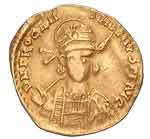 Series Two
Series Two 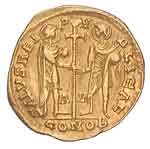
Within a short space of time the obverse bust on the Ravenna solidi was changed to the Eastern style of a facing helmeted and cuirassed bust with spear over the shoulder and shield in the left hand in front (RIC’s KFa). The reverse remained unchanged (RIC 2867-71). This was no doubt on the orders of Anthemius, to make his coinage more like his senior partner’s in the East. It was a striking way of visually symbolizing the reunification of East and West.
While Ravenna produced series two in great numbers (a minimum of five obverse and nine reverse dies) the mints at Rome and Milan remained silent with the exception of a small issue from Rome (RIC 2802: a new obverse die coupled the reverse die from 2801) that employed the new facing Eastern-style portrait and a changed obverse legend, without the ‘PROC’, which nevertheless remained in use at Ravenna until almost the end of series two (3-3 to 6-10).
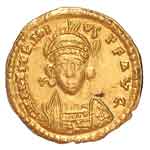 Series Three
Series Three 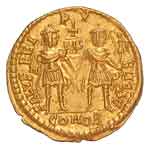
Although Anthemius had been sent to the West by Leo he had not been proclaimed emperor by him (the often-made claim that Anthemius was made caesar and the date of this event are also Seeck’s inventions). It was the army and then the senate in Rome that had first proclaimed him augustus outside Rome. As a result, recognition of the senate’s ratification of the army’s choice still had to be sought from Leo. So a senatorial envoy, Heliocrates, was sent from Rome to Constantinople with imperial icons requesting the acceptance of Anthemius into the imperial college. Many eastern sources make reference to this envoy so it seems that much ceremonial and celebration attended his arrival in Constantinople. The complex ceremonies involving Anthemius’ acceptance are detailed by De caerimoniis (88-9). Unsurprisingly, Leo ratified the West’s choice and for the first and only time following the death of Valentinian III an Eastern emperor recognized a Western colleague as a full member of the imperial college. However, following the precedent set by Marcian, Leo struck no coins in Anthemius’ name (though I like to think that he was depicted on at least one type struck at this time, much as, right at the very beginning of his reign, Valentinian III produced a small issue with a reverse that depicted Theodosius as his senior partner (image) and two very small issues of gold and silver actually in the name of Theodosius II, both so small in fact that they were unknown until recently [images]) and made no reference to him on the reverses of his own coinage, although he did disseminate his icons throughout the East and did include his name in the headings of his laws and in imperial oaths. He also allowed Anthemius to stand as sole consul for 468 and accepted his nominees for the rest of his reign (the only other year since 455 that a Western consul had been accepted in the East was in 461). Leo’s official acceptance of Anthemius, preserved in De caerimoniis, stresses the importance of renewed imperial unity, but once the Vandal expedition had collapsed such ideas were of no practical value and were not heard in the East again until the reign of Justinian. In the West, too, the ‘reunification of the empire’ was the key to Anthemius’ early reign and it was announced most clearly on his coinage, both on the obverses (the Eastern facing bust) and the reverses (the constant appearance of Leo as Anthemius’ senior, but identical and supporting, partner), and in panegyrics, like that of Sidonius, delivered on 1 January 468.
It was almost certainly following the arrival of official notification from the East that Anthemius had indeed been accepted as a full member of the imperial college that a new reverse type was instituted, similar to that used thus far at Rome, with the two standing emperors, draped and cuirassed, but now holding hands in union instead of supporting the globus. Anthemius, on the right, holds Victory on a globe in his left hand while Leo, on the left, extends his right arm across in front of his body and holds a shield between the two figures. The design of Leo’s arm and shield are clearly visible only on the reverses from Ravenna, which demonstrates that the design was conceived there. At Rome, his arm is truncated from his elbow and the shield is but a curved line below his left arm, looking like a fold of drapery. At Milan it is a small but thick lunate curve beside Leo’s knee amidst drapery hanging from his shoulder and his arm is but a stub at the shoulder. Above and between the two emperors, in what was certainly originally intended to be a wreath surmounted by a cross, appears the word PAX. In Milan this became PAS and on one long-lived die, bAS (both being recognized changes: C. H. Grandgent, An Introduction to Vulgar Latin (Boston/New York/Chicago, 1907), pp. 108 and 132-3, though the change of ‘x’ to ‘s’ in a monosyllable like ‘pax’ would be unusual). Kent’s suggestion that this type was somehow related to the marriage of Alypia and Ricimer (p. 195) is implausible. Depeyrot’s claim that they were struck during the siege of Rome in 472 by Ricimer (p. 176) is disproved by the order of the issues (for which, see below). At all mints the mint mark lies on the outside edges of the field. Within series one and series two, a pellet appears in the central field on several reverses at Ravenna (nos. 2, 4, and 11). In series three a pellet appears in the field of another die at Ravenna (no. 12) as well as on three of five dies of 2804 at Rome (two with a large pellet and one with a small one). They appear on later reverses from Ravenna (nos. 20, 25, 26) and in particular as an adjunct to the chi-rho and chrismon symbols and the ligatured mint mark on the series four and five reverses from Rome (2814, 2815, 2816var, 2821fn, 2823fn, 2831, 2832, 2833, 2835var), but they never appear on issues from Milan. They had never appeared on Western issues before and never were to do so again. They went virtually unnoticed by Kent and unfortunately their purpose is unknown.
For some unknown reason, the engravers from Milan, unemployed while series one and two were produced at Rome and Ravenna, produced the dies for both Milan and Rome for this series, while the previous Roman engravers completed the legends. In fact, the first issue of the series was produced from a pair of dies actually cut at Milan (probably the first set cut, since this Rome reverse is the only Milan die to retain the wreath ties seen on the later Rome-engraved reverses). This bizarre situation is proved by the use at Rome of an obverse die known from Milan issues (obv. 1; RIC 2884) paired with a reverse with the typical Milan blunder of PAS for PAX (DO 908; RIC 2804). It is difficult to tell if the R | | M mint mark is original or reengraved. The Milan engraver (or perhaps engravers) seconded to Rome was, unfortunately for Milan, the best engraver they had, though even that is not saying much since his work is clearly inferior to that of the local Roman engravers. Even stranger, however, is the fact that after the first Milan-produced pair, the legends of obverse and reverse were produced by Roman engravers, a conclusion based on a style comparison and in particular upon the characteristic Roman tail on the G of AVG, which never appears at Milan or Ravenna. This tail also appears on an early Roman solidus of Euphemia also engraved in an obvious Milan style (RIC 2805). Consequently it must belong with the 2804 Milan-engraver issues of series three.
For some reason Kent lists nos. 2803-5 of Rome as ‘Milan and Ravenna styles’ (p. 412). As we have just seen 2804 and 2805 are not ‘Milan style’, they were in fact cut by a Milan engraver. On the other hand, there is no hint of a Ravenna style in these issues or any other from Rome, and the reference is puzzling.
After the initial differences between the reverse types issued from Rome and Ravenna in series one and two, from series three onward obverse and reverse designs and legends were centrally disseminated to all mints, though poor communications and unskilled engravers severely reduced the effectiveness of any such directives. This central design is demonstrated clearly by a peculiarity that appears right at the beginning in series three when for some reason the obverse legend is broken a second time by Anthemius’ spear at all three mints: DNANTHEMI-VS-P-FAVG (Rome; three breaks, including one after the spear), DNANTHEMI-VS-PFAVG (Rome, Milan), DNANTHEMI-V-SPFAVG (Rome, Ravenna, Milan), DNANTHEM-IVS-PFAVG (Milan), DNANTHE-MIV-SPFAVG (Milan), and DNANTHEMIV-S-PFAVG (Milan). This ceases with the inception of series four, except at Milan where it continues for one further die (no. 6). At Rome a few dies still depict the spear poking into the legend, but it does not break it (RIC 2803, 2807, 2807var). Attempts were made to establish the legend break at THE-MIVS in period four (religiously kept at Rome), but the lack of skill of the Ravenna engravers meant that this directive could not be met consistently. At Milan they were marching to the sound of a different drummer in this respect, since they seem to have been aiming for THEMI-VS most of the time (an earlier break in series four at Rome), though THE-MIVS is the usual variant from that. Milan’s other deviation in the obverse legend will be noted below in series four.
As noted above, the arrival of the news of Leo’s acceptance seems to be the most likely occasion for a claim of ‘pax’ between the figures of Leo and Anthemius and that would be in the autumn or early winter of 467. The wheels of bureaucracy and ceremonial grind slowly and we know that it took Majorian from 1 April to 31 December of 457 to obtain news of his fate from the East (though it was not the news he had been hoping for). The key to the chronology is the fact that all the Roman engravers, who had produced so little early in the reign and had then been kept from their jobs by a Milan engraver(s) of less talent, were allowed back in to work briefly but then quickly removed from the mint completely and replaced by highly skilled engravers sent from Constantinople. That they came from Constantinople is immediately apparent from a comparison of the products of all three Western mints, in particular the solidi of Anthemius and Euphemia from Rome in series four and five, with the solidi of Leo and Verina from the mint of the Eastern capital down to 468 (RIC 602-607, 629-33). The first evidence of their handiwork appears on the second obverse die of series four (2807) and in particular on the obverse of Anthemius’ consular solidus, struck for 1 January 468 (2806). Series three must therefore fit into the few months of the very end of 467, which suits the return of Heliocrates very well.
The entire output of series one to three must therefore fit into the period of April to December 467. Is this possible? At Rome after the two initial sporadic issues of series one and two in April 467 and soon after (2801-2; two obverse dies and one reverse), there is the series of PAX issues of series three (2804, a minimum of six obverse and five reverse dies) and a series-four issue struck from a at least three pairs of dies, in late December 467 or early January 468 (2803, 2707, 2707var). At Ravenna we have a very large output for all three series involving at least eight obverse dies and thirteen reverse dies, with many more no doubt still to be analysed. The issues for series two were produced from five obverse dies, three of which are closely interlinked with at least seven reverses. Only one obverse and two reverse dies were used for series three (known from five specimens), the lowest output of any of the three mints. At Milan nothing was struck in series one or two. For series three a minimum of five obverse dies were used (one of which continued in use into series four) along with a minimum of three reverse dies, though only one for the bulk of the surviving coinage (no. 3). Since my specimen count is only preliminary, we must assume that further dies will be revealed by future research.
To judge from the dies employed by the mints under Majorian and Severus, such a large output could not be fit into such a short space of time, but Anthemius had three basic duties once he arrived in the West: conciliate Ricimer, the existing patricius et magister militum, and his commanders with himself and Marcellinus, the new patricius et magister militum sent from Constantinople with Anthemius; muster the largest army he could; and amass as much money as possible to pay for this army, its equipment, and its provisions. This had to be completed within about twelve months. If we think back to Majorian’s reign and the length of time it took for him to mount his ill-fated Vandal expedition between 458 and 460 we can see how difficult Anthemius’ task was. Since Anthemius needed money almost immediately from the moment of his accession to begin preparations for the coming campaign, the large output (and the excessive wear of the Ravenna dies) seems entirely appropriate, though this need for cash is hard to reconcile with the quiescence (or near quiescence) at the mints in Rome and Milan for series one and two: perhaps it simply took time to collect the gold and begin coining it, perhaps it was the problems with the engravers in Rome.
What the problems were with the Roman engravers is unknown but clearly they existed from the time that Anthemius arrived in Rome, if we are to judge from the dearth of coins from that mint’s engravers before series three. Any number of possibilities could be imagined, but almost certainly the problems there and perhaps at Milan led to the request for new engravers from Constantinople. I suspect that this request was made early in the summer, since the engravers seem to have arrived in Rome in December. These new engravers could not only produce dies of exceptional quality and consistency but they could do so in large quantities and quickly.
With the completion of series three Rome, now staffed with highly-skilled professional die makers, becomes Anthemius’ chief mint, producing almost as many obverse dies in series four alone as all other obverse dies produced at all three mints between 467 and 472 (52:64; see below), and it begins its minting of series four with a return to the very first reverse type used at Rome in April of 467. This design was then sent to the other mints, which had never employed it before.
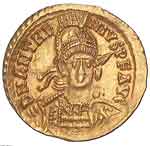 Series Four
Series Four 
The consular solidus from Rome, unknown until it was published from a private collection 1987, is a copy of Majorian’s consular type (RIC 2601-3), rather than of Leo’s Eastern consular types up to that date (RIC 603-4, 620-7)—as one might expect given the involvement of new engravers fresh from the Eastern capital—not only in its facing obverse portrait and meaningless reverse legend (VOTIS MVLTIS), but right down to the two consuls depicted on the reverse, even though Anthemius was sole consul for that year. This suggests some haste and miscommunication in the use of the model for the execution of the reverse type.
Interestingly, in spite of the arrival of the new engravers, the locals were allowed a few last kicks at the can: 2803 shows a strong and unique style, perhaps local, probably developed under the tutelage of the new engravers, while the reverses of 2806, the consular type, and 2807, a regular series four type, show improved good work from a local Roman engraver. But with the exception of one or two other later dies these were to be the last from the local engravers. The new engravers also brought from Constantinople a change to the obverse legend: Leo’s name was so short that something was needed to fill out his legend and so PERPET was added in the place of PF. A shortened version, PERP, appears on the first two Eastern-engraved dies (2807), as if to try out the spacing, and then the full PERPET appears on the consular solidus and the contemporary period four obverses (2808, two dies so far). This was quickly cut back to PE (2809-10, one obverse die) and then the usual PF was reinstated shortly afterwards (2811). Series four no doubt appeared soon after the beginning of the new year in Milan and Ravenna.
Throughout most of series two Ravenna had retained the original obverse legend with PROC, but right at the end abandoned it and shifted to the standard D N ANTHEMIVS P F AVG (obv. 7; 2871). It retained this style (with various random breaks that were aiming for THE-MIVS) right through to the end of minting. Rome and Milan use this style on their series three types, and it derives from the standard Western obverse legend. Then with the advent of series four, under the influence of the Eastern engravers, as noted above, the legend was extended at Rome and Milan to include PERP (Rome), PERPET (Rome and Milan), PERPETV (Milan), and PE (Rome and Milan) in the place of PF. After a few dies with these variations (2807-10) Rome quickly settled back to the PF-style (from 2811), while Milan only employed PF during series four and five on two dies (obv 11 and 13) favouring instead PERPETV, until settling down with PE at the end of series five. This again shows the independence of the mint at Milan.
A characteristic of series four is that all mints
attempt to add the mint mark to the exergual COMOB, the guarantee of officially
sanctioned gold purity: CORMOB at Rome, CORVO at Ravenna, and CO OB at
Milan. It lasted but one die at
the last two, but became common at Rome, and appears on issues for both
Anthemius and Euphemia. As can be
seen from the analysis, both forms were employed contemporaneously.
OB at
Milan. It lasted but one die at
the last two, but became common at Rome, and appears on issues for both
Anthemius and Euphemia. As can be
seen from the analysis, both forms were employed contemporaneously.
There is no satisfactory explanation for the strange
changes in the reverse legend breaks, mint marks, exergue, and symbols at Rome
in series four and, to a lesser extent, in series five and at Ravenna in series
five. Unfortunately Kent’s
description and cataloguing of these marks is inadequate. Die links at Ravenna (from 11-17 to
15-23 and 17-25 to 17-27) and at Rome (2809 and 2810; 2810/2812 and 2818;
2816fn and 2823; 2816 and 2823; 2823fn, 2816var, 2814var, 2816, 2814, and 2820;
2824 and 2823var; 2823, 2816, 2832, 2831, 2835, 2831, and 3831var; 2830 and
2833; 2833 and 2834fn; and 2835 and 2835var; see analysis) show that these
varying marks are not mint officina markers and that they do not follow any
type or chronological progression.
They remain the most baffling aspect of the issues of Anthemius. Ravenna did follow Rome and shift the
reverse legend break from PV to EIP and (rarely) IPV, but they also produced
their own unique break with EIPV on three late dies of series five (nos. 26-8,
one blundered). At Milan no
attempt was made to change and PV is the standard break until right at the end
of series five when the new engravers introduced the unique break IP. For a table showing the chronological
progression of the symbols, mint marks, and legend breaks at Rome for series
four, see the Rome analysis. As
can be seen from the numbers of surviving specimens, the standard series-four
types from Rome were 2816 (EIP //  / COMOB) and 2823 (EIP //
/ COMOB) and 2823 (EIP //  / CORMOB). And just as at Rome there is a die that shows a chi-rho
reengraved over RM (2816fn) there is a die at Ravenna that shows a pellet
reengraved over a star (2876, 12-20).
In neither case is there any evidence (so far) for the use of the
original unaltered die.
/ CORMOB). And just as at Rome there is a die that shows a chi-rho
reengraved over RM (2816fn) there is a die at Ravenna that shows a pellet
reengraved over a star (2876, 12-20).
In neither case is there any evidence (so far) for the use of the
original unaltered die.
There is a large block of die-linked material from
Rome for series four involving ten specimens with four obverses and six
reverses (see analysis). One
obverse in particular was used with all six reverses while the other three
obverses link to reverses 1, 4, and 6 in the sequence. In this case the chronology is provided
by developing die flaws on the first obverse. This highlights Anthemius’ need to produce a large amount of
coinage in a short space of time as we suspect was the case throughout series
four as he struggled to produce the needed cash. This can also be seen in the long linked sequence that
extends from series four into series five where five obverse dies link with a
single reverse (the exact opposite of what one would expect), but at the same time
one of those obverse dies also links to two different reverse dies, not shared
with any of the other obverses, one of the shared type (2823;  / CORMOB), but one with a different type
(2816;
/ CORMOB), but one with a different type
(2816;  / COMOB). Once again the complexity of the linking shows the continued
need for coinage even at the end of series four (and, as we shall see) into
series five.
/ COMOB). Once again the complexity of the linking shows the continued
need for coinage even at the end of series four (and, as we shall see) into
series five.
Note that while Kent lists the cross as a separate symbol on p. 196, he correctly includes it with the crossed-rho chrismon in the catalogue (p. 413 n. 2814). There is also a mistake on p. 196 with respect to the symbol that is found engraved over the RM: it is a chi-rho not a star (see p. 413 n. 2816, correctly, but (again) not with its own number). With respect to Ravenna, on p. 195 he states that there is ‘always a star in mid-field’ of the reverse. As can be seen from the RIC catalogue and my analysis here, this is untrue. There are a number of other variants between the introduction and the catalogue. Kent seems to have written the former early in the process of producing the book and never returned to it when he later changed the catalogue.
The chronology of the switch from the cuirassed Eastern-style (KF) busts of series four to the distinctive and unique draped bust (MF) of series five, and therefore the conclusion of series four, cannot be ascertained. At Rome and Milan (strangely, the output of series four types was negligible at Ravenna: 2873 and 2874; nos 9-14 and 9-15) series four was much larger than any other series. No doubt much of the initial production took place during the first half of 468 in order to pay for the Vandal expedition, but after the failure of the expedition one would have expected the production to have been very sporadic since no doubt much of the Western reserves would have been coined in anticipation of the expedition, which, in the end, got no further than Sicily, when Marcellinus, the patricius et magister militum, was assassinated, no doubt through the intrigues of Ricimer, who again became sole patricius et magister militum. At the other end, the minting of series five in Rome certainly cannot have continued much beyond October of 471, when Ricimer’s siege of the city probably began. Milan and Ravenna almost certainly ceased striking for Anthemius in April 472, when Olybrius was proclaimed emperor by Ricimer, if not before. The intensity of minting obvious from the linked sequence from 2823 to 2831var, from series four into series five, could suggest that this was still part of the output of 468 (mercenaries and soldiers would still have to have been paid after the collapse of the expedition) , but that hardly seems possible since we are looking at well over fifty obverse dies employed at Rome in series four. Perhaps we are looking at another military crisis, hundreds of pounds of gold coined to pay troops in Gaul, to pay off Goths or Vandals, or to win back the loyalty of soldiers who revolted under Ricimer in 470-471. The historical record is so thin that we can do no more than guess.
 Series Five
Series Five 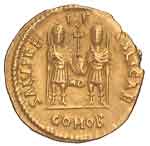
The origin of the unusual bust type of series five (RIC’s MF) is unknown. It otherwise only appears on a few Constantinopolitan bronzes of Arcadius from the very beginning of the fifth century (RIC 85, 87, 90), which can hardly have been an inspiration seventy years later in the West. Kent mentions the famous but lost ‘SALVS ET GLORIA ROMANORVM’ multiple of Justinian from 534 (p. 196; see also p. 70), which offers a similar type, though Justinian holds his spear in front, not over his shoulder. Again, its engravers certainly did not find their inspiration in Arcadian bronzes or Western solidi of Anthemius. All must be tapping into an imperial iconography that we know nothing of, perhaps one of victory since although the emperor is still garbed for war he appears to be returning from battle, cloaked for travel, his shield out of the way on his back.
Production at Rome was considerably lower than in
series four, which on present count comprises about two and half times more
obverse dies that series five (52:19), and the many
variations within the coinage settled down: most of the field symbols were
eliminated (though pellets, a loop, and a star still make an appearance), the
reverse legend break remained fixed (EIP), COMOB remained fixed (though with
pellets and Xs), and the obverse legend did not vary (as it had not after the
first few dies of series four). However, pellets were added to the top and arms of the reverse cross on one common type (2835). As
can be seen from the mint analysis the reverse types with their various symbols
in the field and exergue link up just as randomly as they did in series
four. As was also the case with
series four there is a large block of die-linked material, in this case
involving forty-four specimens, thirteen obverse dies, and ten reverse dies of
which seven obverses and three reverses appear to have been employed nearly
simultaneously (again note the strange predominance of obverse dies). This linked series extends from the end
of series four into series five.
As noted above, we know of nothing in the historical record that would
help us date this burst of intense production. The standard reverse types for series five at Rome were 2831
(EIP //  /COMOB) and 2835 (EIP // :+: /
/COMOB) and 2835 (EIP // :+: /  / COMOB).
/ COMOB).
Ravenna returned to prominence in series five with a (comparatively) large output, some of it perhaps in part to compensate for the reduction in Rome’s output during the same series. Engravers had trouble understanding what was expected of them on the new obverse and at first changed the cuirassed torso with shield (KFa) into the standard draped and cuirassed torso that had appeared on earlier on Western obverses (RIC's D type) while retaining the helmet and spear of the KFa type (obv. 10). This was quickly modified to a new draped torso covered with simplistically engraved drapery: a vertical striped band up to the right shoulder (retained from the KFa type), horizontal and parallel curved folds across the chest (with further vertical folds below that on the first die), and a single brooch (?) and pteryges on the left shoulder, retained from the D type (obvv. 11 and 12). This was soon altered to the correct design, as seen on the Rome and Milan obverses, with a single brooch on the left shoulder and the cloak’s folds flowing down from it (obvv. 13 to 18), though the engravers never really understood that the curve over the left shoulder was supposed to be the emperor’s shield, slung onto his back (there is no shield in the earlier attempts at the style), and so it just became two additional folds of drapery.
As is the case on series four and five reverses at Rome, Ravenna’s series five reverses display a bewildering variety of symbols and marks, beginning with a star over the RV mint mark (revv. 16-18, 25; and for some reason on the first three dies the V is placed higher than the R), a star (19, 24), a pellet over the RV (reengraved from a star: 20; original: 26, 27), a star beneath the RV (21), and RV alone (22, 23, 28). Sloppiness, it would seem, resulted in a COMOD on a three dies (17, 20, 26).
Milan’s output on the other hand remained about the
same (seven obverse and five reverse dies vs. six obverse dies and nine reverse
dies in series four, with more series five reverses no doubt still to be
catalogued) and like Ravenna still tended to push its dies beyond their
appropriate limit in order to squeeze more coin out of less engraving work. In addition, for some reason a new
engraver(s) arrived after the production of at least three obverses that showed
the facing draped bust to be beyond the capabilities of the existing
engraver(s) (obvv 12, 13, and 14).
This new engraver was highly skilled, though less so than the
Constantinopolitan engravers at Rome.
Along with the new engraver came the change of the reverse legend break
from PV to IP. As in the first
part of series five, the mint mark tended to be ligatured, just like the
series-five mint mark in Rome.
This was clearly a centrally-made decision, but the reason for it is
unknown.
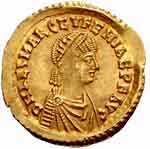 The Overall Order of the Five Series at All Mints
The Overall Order of the Five Series at All Mints 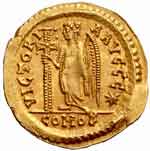
There can be no doubt that the earliest types are those from Rome and Ravenna carrying the standard diademed draped and cuirassed Western bust type (D) and the legend that includes PROC, neither of which appear at Milan. There is a reverse die link between 2801 and 2802 at Rome, which shows the progression from the original D type bust to the Eastern helmeted and cuirassed bust with spear and shield (KFa), a progression that is seen at Ravenna as well, since the same reverse type was used there for both series one and series two, the tall cross type. Rome employed a different reverse for these issues, the globus cruciger type, but the D obverse and its change to KFa prove the simultaneity of the issues from both mints. Thus even though Rome’s first reverse is the globus cruciger type, which is used at all mints later on, the D obverse and the local style (see below) prove that it does not belong with those later issues. At Ravenna the PROC continues in the obverse legend with the same KFa obverse busts and tall cross reverses after the change from the D obverse, though it is eventually dropped for good from the legend near the end of the series. This change serves to segregate the D/tall cross and KFa/tall cross types from the other series and again confirms that these two types must begin the minting sequence under Anthemius.
The arrival in Rome in late 467 of new engravers from Constantinople also serves to neatly mark what came before from what followed, since the style is so strikingly different. This stylistic change demonstrates that the local-style D/globus cruciger and KFa/globus cruciger types as well as the Milan-engraver KFa/Pax series, must predate the arrival of these engravers, while the other new-style globus cruciger reverses must post-date it. One of the first products of these new engravers were 2807 and 2807var as well as 2806, the consular solidus of 1 January 468, which included the Eastern-style title PERP and PERPET. This legend change from the standard PF is also seen in the next group of dies of the new-style globus cruciger reverses at Rome, before the title was reduced to PE and then finally back to PF. At Milan PERPETV extended right through the KFa/globus cruciger into the MF obverses, where it finally changed to PE (which had appeared briefly earlier on), but it still nevertheless shows the direction of the type change. The die-linked sequence at Milan of 2-2 to 10-13 shows the direction of the link chronology from the PAX series into the KFa/globus cruciger series, thus firmly establishing that sequence, which must therefore follow the D and first KFa series at Rome and Ravenna. A change of engravers at Milan (from clumsy to competent) at Milan at the end of the MF series and the fact that Olybrius’ obverse portrait is an unarmed version of the MF type, along with the obverse legend change at Milan noted above, demonstrate conclusively that the MF series must post-date the various KFa series and must therefore be the last series of the reign. This also confirms the proper direction for the series four to five linked series at Rome.
As a result, the order must be as follows:
Series One: Rome and Ravenna only: D/globus
cruciger , Rome (local style), and
D/tall cross, Ravenna
Series Two: Rome and Ravenna only: KFa/globus
cruciger, Rome (local style), and
KFa/tall cross, Ravenna
Series Three: all mints: KFa/PAX, Rome (Milan engravers)
and Ravenna, and KFa/PAS, Milan
Series Four: all mints: KFa/globus cruciger, Rome (early RM types and new style), Ravenna, and Milan
Series Five: all mints: MF/globus cruciger, Rome (new style), Ravenna, and Milan (new style at
end)
Comparison of the Output from All Three Mints
|
Series |
Rome obv - rev |
Ravenna obv - rev |
Milan obv - rev |
Totals obv - rev |
|
One |
1 - 1 |
2 - 2 |
0 - 0 |
3 - 3 |
|
Two |
1 - 1 |
5 - 9 |
0 - 0 |
6 - 10 |
|
Three |
7 - 6 |
1 - 2 |
5 - 3 |
13 - 11 |
|
Four |
53 - 50 |
1 - 2 |
7 - 10 |
60 - 62 |
|
Five |
19 - 19 |
9 - 13 |
7 - 5 |
35 - 37 |
|
Totals |
80 - 76 |
18 - 28 |
18 - 18 |
116 - 122 |
|
Specimens |
151 |
50 |
68 |
269 |
Notes: The totals for Rome include Euphemia. Series four for Rome includes the consular dies. There is a shared reverse die between series four and series five at Rome and a shared obverse die between series three and series four at Milan.
Although the totals offered here are still preliminary the general ratios are probably reliable.
Further Specific RIC Catalogue Errors
Legends
No care has been taken to distinguish between ‘AVG’
and ‘AVC’.
No account has been taken of the extra break in the
legend caused by the spear point in series three obverses.
No account has been taken of the missing jewel and/or
trefoil on many of the obverse helmets (cf. Zeno, RIC X p. 306).
An12 should read ‘D N A TH-EMIVS P F
AVG’
TH-EMIVS P F
AVG’
An16 should read ‘D N ANTEHEMIV-S PERPETV AVC
An24 should read ‘D N ANTHEM-IVS P E AVG’ (as on p.
lxiv).
Eu3 should read EVEEMIAE (as Kent notes himself on p. 196)
Rome
2803-5 title above: 2803 is an improved though rather
unusual court style (hardly Ravenna style), whereas 2804-5 are not just Milan
style but the work of a Milan engraver.
2814: this is the only numbered type that includes a
pelleted symbol. A pellet is
mentioned for 2821 and 2823 in a note only. In general no care has been taken to catalogue the
appearance of these pellets.
2817: this specimen is not in Oxford
2817, 2818, 1819, 2824, 2826: photos are missing for
these specimens.
2821: listed as a chrismon, but the photo is a pelleted chrismon.
Ravenna
2869: The specimens with the variant reverse legend
should have been assigned a separate number. There is no photo of this specimen.
2871: As can be seen from the photo the obverse
legend is not An11 but ‘D N ANTHE-MIVS P F AVG’, which is not listed.
2872: As can be seen from the photo the obverse
legend is An9 not An8.
2873: As can be seen from the photo the reverse
legend is misdescribed (‘-IVB-’ not ‘–PVB–’).
2873-80: no attempt has been made to distinguish the
reverse types that have the star above the mint mark and those that have it
below. Likewise, no attempt has
been made to describe the small pellet that appears on a variety of reverses
here and in series two.
2878, 2880: photos are missing for these specimens.
2882: As can be seen from the photo the reverse
legend is misdescribed (‘SALVS-FIPV-’ not ‘SALVS R-EIPV-’).
Two specimens contained in the British Museum collection were missed by Kent, my 10-16 and 11-18. One offers a variant obverse bust and the other a variant obverse legend unrecorded by Kent. Other coins, types, and collections have been missed by Kent, and that is to be expected, but for him to have missed two of his own coins is worrisome.
Milan
2887, 2888, 2896: photos are missing for these
specimens.
2889: As can be seen from the photo and the
references cited (UB 124* = DO [914] = Lacam 93) the obverse legend is An11 not
An23, which means that 2887 and 2889 are the same.
2890: The specimens with the variant reverse legend
should have been assigned a separate number.
2892: The reverse is misdescribed (‘SALVREI-’ not ‘SALVSREI-’) and the obverse is the same as 2890.
2893: Although it is not so indicated by Kent the
difference between 2891 and 2893 is that the latter has a ligatured mint mark
with two superimposed dots.
2894-5: The ligatured mint mark is not indicated.
2894: UB 120 now resides in Berlin (elsewhere
recorded by Kent). The footnote
simply repeats the reference and is not necessary.
2896: UB 119 now resides in Berlin (elsewhere
recorded by Kent). The footnote
simply repeats the reference and is not necessary.
2897: there is no specimen of this type in Stockholm
A Note on the Following Analyses
The following analyses are based on a collection of material from a number of important public collections, published specimens, and recent auctions (since 2000). It does not yet include much material from older printed sale catalogues, from many hoards, and from other public collections. This material will eventually be added. What this means is that certainly more obverse and reverse dies remain to be catalogued. When these are found, they will be added with a letter suffix (17a, for instance). Eventually, when the analyses are complete and published the entire system will be renumbered. But for the foreseeable future this system can be used with confidence to describe coins. Although I have collected a very large selection of solidi for Rome, the output was very large and I have so many unique examples of dies that it is impossible to create a die link diagram as is the case with Ravenna and Milan. As a result I have adopted a different format for Rome from the other two mints.